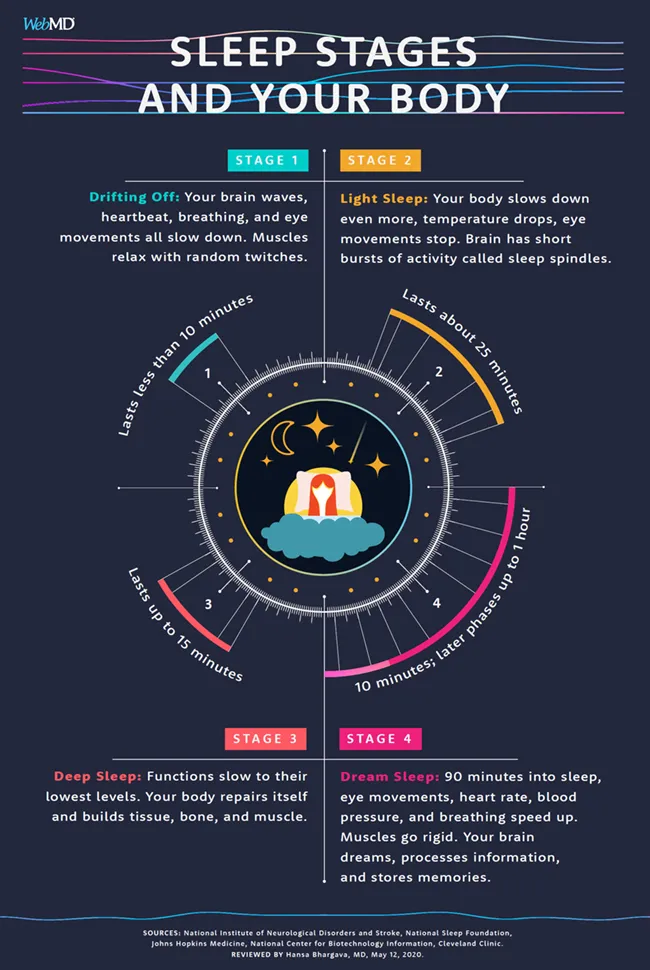REM Sleep vs. Non-REM Sleep
A lot happens in your body while you sleep. When you get your ZZZs, you go back and forth between REM and non-REM sleep.
REM stands for rapid eye movement. During REM sleep, your eyes move around rapidly in different directions, and your brain is active. Your brain activity is similar to its activity when you’re awake. Dreams typically happen during REM sleep.
During non-REM sleep, your brain is not as active. And in the deeper stages of non-REM sleep, your breathing slows down, and your blood pressure drops.
After you fall asleep, non-REM sleep comes first, followed by a shorter period of REM sleep, and then the cycle starts over again.

Stages of Sleep
When you sleep, you go through cycles that last between 90 and 120 minutes. Each cycle includes three stages of non-REM (NREM) sleep and a stage of REM sleep.
Here are the three stages of NREM sleep. You go through all three of them before you get to REM sleep.
Stage 1. Your eyes are closed, but it's easy to wake you up. This phase may last for 5 to 10 minutes.
Stage 2. You are in light sleep, but it’s deeper than stage 1. Your heart rate and breathing slow down, and your body temperature drops. Your body is getting ready for deep sleep. This can last for 10-25 minutes.
Stage 3. This is the deep sleep stage. It's harder to rouse you during this stage, and if someone woke you up, you would feel disoriented for a few minutes. In adults, stage 3 makes up about 25% of total sleep time.
During the deep stages of NREM sleep, the body repairs and regrows tissues, builds bone and muscle, and strengthens your immune system.
As you get older, you sleep more lightly and get less deep sleep. Aging is also linked to shorter periods of sleep, although studies show you still need as much sleep as you did when you were younger.
After NREM sleep, you move into the REM stage. After REM sleep, you start another cycle. If you get 8 hours of sleep each night, you usually go through four or five cycles.
What Is REM Sleep?
Usually, REM sleep happens 90 minutes after you fall asleep. The first period of REM typically lasts 10 minutes. Each of your later REM stages gets longer, and the final one may last up to an hour. Your heart rate and breathing quicken.
Your muscles usually go limp so that you don’t act out your dreams. You can have intense dreams during REM sleep since your brain is more active.
REM is important because it stimulates the areas of your brain that help with learning and memory. During this stage, your brain repairs itself and processes emotional experiences. It also transfers short-term memories into long-term memories.
Lack of REM Sleep Symptoms
If you don’t get enough REM sleep, here are some symptoms you may have:
- Difficulty remembering things, either short term or long term
- Trouble coping with emotions
- Trouble concentrating
- A weakened immune system
- Feeling groggy in the morning
If you have these symptoms, you may want to try to increase your REM sleep.
How to Increase REM Sleep
To increase your REM sleep, you need to get more sleep overall. Here are some ways to improve your sleep and get more sleep:
- Create a relaxing bedtime routine to help you wind down each night.
- Set a sleep schedule and stick to it. Try to wake up and go to bed at the same time every day.
- Avoid nicotine and caffeine.
- Exercise and spend some time outside in natural sunlight every day.
- Avoid alcohol and meals close to bedtime.
- Avoid TV and electronics before bed because the light from these screens can interfere with your sleep.
Too Much REM Sleep
Sometimes, you may spend more sleep time than usual in the REM stage. Your REM sleep can be more frequent, deeper, and more intense. This is called REM rebound, and it can happen if you’ve been sleep deprived, meaning you’ve been getting less than 7 hours of sleep per night. Also, if you’ve been dealing with significant stress or drug withdrawal, that can lead to REM rebound. It’s your body’s way of trying to restore balance in your sleep cycle.
Signs of REM rebound include:
- Especially vivid dreams or nightmares
- Feeling disoriented or confused when you wake up
- Headaches
Usually, REM rebound sleep will decrease if you improve your overall sleep.
How Much Deep Sleep Do You Need?
The amount of time you spend in each stage of a sleep cycle can change during each night, but also over your lifetime. For example, babies spend a lot of time in the REM stage, up to 50% of their sleep. Adults spend only about 20% in REM.
Stage 3 of NREM sleep is the deep sleep stage. Children get the most deep sleep, and teenagers get less of it. The amount of deep sleep you get as an adult continues to decrease as you age. You typically spend about 25% of your sleeping time in stage 3, but this amount decreases with age.
Overall, the amount of sleep people need depends on their age. Here’s how much sleep you should get daily:
- Babies up to 12 months old: 12 to 17 hours (including naps)
- Children up to 5 years old: 10 to 14 hours (including naps)
- Children between 6 and 12 years old: 9 to 12 hours
- Teenagers: 8 to 10 hours
- Adults: 7 to 9 hours
If you’re an adult getting 8 hours of sleep each night, spending 25% of it in stage 3 would mean you spend about 2 hours in deep sleep.
Takeaways
Each time you go to sleep, you start a new sleep cycle that goes from non-REM stages to a REM stage. The REM stage is usually when you dream, and your deepest sleep happens during non-REM sleep. Both REM sleep and non-REM sleep are important because while you’re asleep, your brain and body are busy repairing and strengthening things as well as processing memories. If you don’t get enough sleep, it can affect your physical and mental health and your overall well-being.
REM FAQs
Which is better, REM or non-REM sleep? You need both REM and non-REM sleep. REM sleep is important for your learning and memory, and non-REM sleep is when your body repairs and regrows tissues.
What is the main difference between NREM and REM sleep? During REM sleep, your eyes move rapidly and your brain is active. Deeper sleep happens during NREM sleep, when your heart rate and body temperature decrease.
Is REM sleep good for you? Yes. REM sleep is important for your learning and memory, and it helps you concentrate and regulate your mood.
What is non-REM sleep good for? Non-REM sleep is when your body repairs and regrows tissues and builds bone and muscle. Non-REM sleep also helps strengthen your immune system.
What does REM sleep cycle mean? Every night, you go through sleep cycles, and each cycle includes a REM stage and three non-REM stages. If you sleep for 8 hours per night, you may go through four to five sleep cycles.

